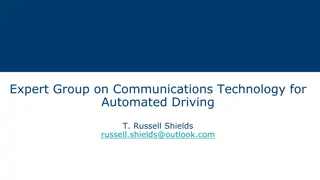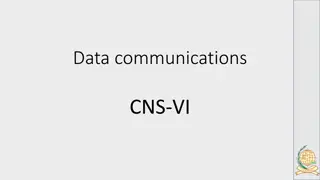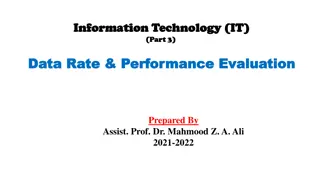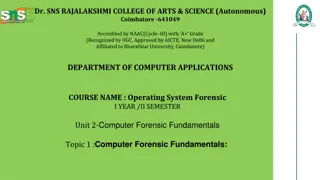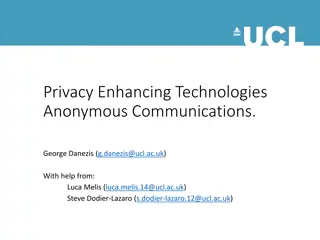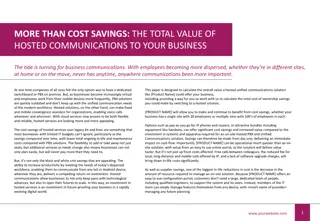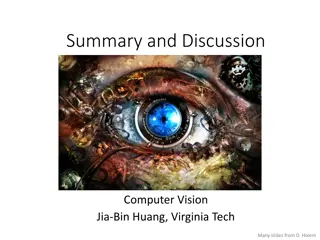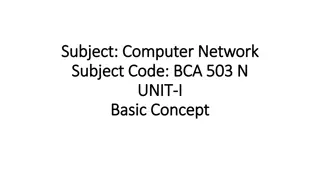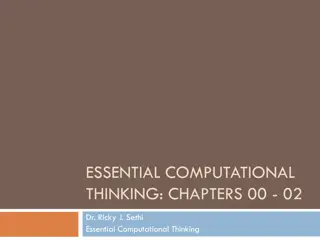Fundamentals of Data and Computer Communications Explained
In this tutorial, we delve into Chapter 6 of data and computer communications, focusing on transmission overhead calculations, asynchronous and synchronous communication comparisons, CRC computation, and character transmission requirements. Learn about start bits, stop bits, control bits, parity bits, and more essential concepts in networking and communications.
- Data communications
- Computer networks
- Networking fundamentals
- Transmission overhead
- Synchronous communication
Download Presentation

Please find below an Image/Link to download the presentation.
The content on the website is provided AS IS for your information and personal use only. It may not be sold, licensed, or shared on other websites without obtaining consent from the author. Download presentation by click this link. If you encounter any issues during the download, it is possible that the publisher has removed the file from their server.
E N D
Presentation Transcript
1 NET 222: COMMUNICATIONS AND NETWORKS FUNDAMENTALS (PRACTICAL PART) Networks and Communication Department Tutorial 4: Chapter 6 Data & computer communications
Chapter 6 page 204 (Data & computer communications) 2 Problems: 6.1 Questions on ch 6. Networks and Communication Department
Question 3 6.1 Suppose a file of 10,000 bytes is to sent over a line at 2400 bps. a) Calculate the overhead in bits and time in using asynchronous communication. Assume 1 start bit and a stop element of length 1 bit, and 8 bits to send the byte itself for each character. The 8-bit character consists of all data bits, with no parity bit. Total # of start bits=1x10,000=10,000bits Total #of stop bits=1x10,000=10,000bits Overhead in bits=Total # of start bits + Total # of stop=20,000 bits Overhead in time=overhead in bits / data rate = 20,000/2400=8.33 seconds b) Calculate the overhead in bits and time using synchronous communication. Assume that the data are sent in frames. Each frame consists of 1000 character= 8000 bits and an overhead of 48 control bits per frame. Overhead=48 bits/frame # of frames =10,000/1000 =10 frames Overhead in bits=# of frames x # of control bits =10x48=480 bits Overhead in time=overhead in bits / data rate =480/2400 =0.2 second Networks and Communication Department
Question (Cont.) 4 d) What would the answer to parts (a) and (b) for the original file of 10,000 character except the data rate of 9600 bps? For asynchronous : Overhead in bits :same as (a) Overhead in time=20,000/9600=2.08 seconds For synchronous : Overhead in bits :same as (b) Overhead in time=480/9600 =0.05 second Networks and Communication Department
Question 5 For P=1011 and D=1010011110 ,find the CRC D= 1010011110 K=10 bits P=1011 n=p+k-1 4+10-1=13 Fcs =n-k=13-10 =3 Networks and Communication Department
Question on Ch 6 6 Q.1 If we want to transmit 1000 ARI character(7- bit character) asynchronously, what is the minimum number of extra bits needed? Assume parity bit is used. Total # of start bits=1x1000=1000 bits Total # of stop bits=1x1000=1000 bits Total # of parity bits=1x1000=1000 bits Minimum # of extra bits = 1000+1000+1000=3000 bits Networks and Communication Department
Question 7 Q.2 We want to transmit 1000 characters with each character encoded as 8 bits. Find the number of transmitted bits for asynchronous transmission a. use one start bit and two stop bits Total # of start bits=1x1000=1000 bits Total # of stop bits=2x1000=2000 bits Total # of data bits=8x1000=8000 bits Total # of bits to be transmitted = # of data bits + # of extra bits = 8000+(1000 + 2000)=11000 bits b. use one start bit and two stop bits with parity bit Total # of start bits=1x1000=1000 bits Total # of stop bits=2x1000=2000 bits Total # of parity bits= 1x1000=1000 bits Total # of data bits=8x1000=8000 bits Total # of bits to be transmitted = # of data bits + # of extra bits = 8000+(1000 + 2000 +1000)=12000 bits Networks and Communication Department
Question 8 Q.4 Assuming even parity, find the parity bit for each of the following data units: a) 1001011 1001011 0 b) 0001100 0001100 0 c) 1000000 1000000 1 d) 1110111 1110111 0 Networks and Communication Department
Question 9 Q.5 A receiver receives the bit pattern 01101011. if the system is using even parity, is the pattern in error? yes because the total number of 1 s is odd Networks and Communication Department
Question 10 Q.7 Given a remainder of 111, a data unit of 10110011, and a divisor of 1001, is there an error in the data unit? No error because the reminder is 0 Networks and Communication Department
Question 11 Q.8 If a divisor is 101101, how many bits long is the CRC? 5 bits Networks and Communication Department
The End 12 Any Questions ? Networks and Communication Department




